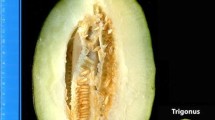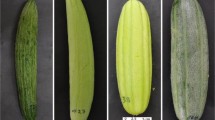Abstract
Fruit traits, such as shape, size, sugar concentration, and β-carotene concentration affect fruit quality in melon. Extensive genetic diversity for these traits can be exploited for breeding purposes. In this study, an F2 mapping population was constructed using an orange fleshed cantaloupe-type melon and an exotic green fleshed “snake melon” to identify quantitative trait loci (QTL) associated with fruit quality and fruit morphological traits. A total of 31 QTLs were identified, of which 23 corroborated previously reported QTLs. A small segment of LG8 explained most of the phenotypic variation for yield. We mapped eight new QTLs for fruit shape, total fruit weight per plant, soluble solids concentration, flesh color, ovary shape and seed cell diameter, and a locus for chlorosis in this study. Soluble solids concentration did not have significant association with average fruit weight and fruit width, suggesting that manipulation of fruit morphology is possible in melon without considerably affecting fruit sweetness. A significant positive association between fruit shape and ovary shape indicated that fruit shape was determined during preanthesis. Our results indicate that natural variation for internal and external melon fruit traits can be further explored by performing QTL analysis of populations derived from crosses between previously unexplored botanical groups.




Similar content being viewed by others
References
Adams C, Richardson M (1981) Nutritive value of foods. USDA Home Gard. Bul. 72. US Government Printing Office, Washington, DC
Clayberg CD (1992) Interaction and linkage tests of flesh color genes in Cucumis melo L. Cucurbit Genet Coop Rep 154:53
Cuevas HE, Staub JE, Simon PW et al (2008) Mapping of genetic loci that regulate quantity of beta-carotene in fruit of US western shipping melon (Cucumis melo L.). Theor Appl Genet 117:1345–1359. doi:10.1007/s00122-008-0868-2
Cuevas HE, Staub JE, Simon PW, Zalapa JE (2009) A consensus linkage map identifies genomic regions controlling fruit maturity and beta-carotene-associated flesh color in melon (Cucumis melo L.). Theor Appl Genet 119:741–756. doi:10.1007/s00122-009-1085-3
Diaz A, Fergany M, Formisano G et al (2011) A consensus linkage map for molecular markers and quantitative trait loci associated with economically important traits in melon (Cucumis melo L.). BMC Plant Biol 11:111. doi:10.1186/1471-2229-11-111
Díaz A, Zarouri B, Fergany M et al (2014) Mapping and introgression of QTL involved in fruit shape transgressive segregation into “Piel de Sapo” melon (Cucucumis melo L.). PLoS One 9:e104188. doi:10.1371/journal.pone.0104188
Eduardo I, Arus P, Monforte AJ et al (2007) Estimating the genetic architecture of fruit quality traits in melon using a genomic library of near isogenic lines. J Am Soc Hortic Sci 132:80–89
Fernandez-Silva I, Moreno E, Essafi A et al (2010) Shaping melons: agronomic and genetic characterization of QTLs that modify melon fruit morphology. Theor Appl Genet 121:931–940. doi:10.1007/s00122-010-1361-2
Food and Agricultural Organization of the United Nations and World Health Organization (2001) Human vitamin and mineral requirements. Report of a joint FAO: WHO expert consultation. Bangkok/Rome, Thailand, Food and Agricultural Organization of the United Nations
Fukino N, Ohara T, Monforte AJ et al (2008) Identification of QTLs for resistance to powdery mildew and SSR markers diagnostic for powdery mildew resistance genes in melon (Cucumis melo L.). Theor Appl Genet 118:165–175. doi:10.1007/s00122-008-0885-1
Harel-Beja R, Tzuri G, Portnoy V et al (2010) A genetic map of melon highly enriched with fruit quality QTLs and EST markers, including sugar and carotenoid metabolism genes. Theor Appl Genet 121:511–533. doi:10.1007/s00122-010-1327-4
Harjes CE, Rocheford TR, Bai L et al (2008) Natural genetic variation in lycopene epsilon cyclase tapped for maize biofortification. Science 319:330–333. doi:10.1126/science.1150255
Hughes MB (1948) The inheritance of two characters of Cucumis melo and their interrelationship. Proc Am Soc Hortic Sci 52:399–402
Kang H, Cho Y, Yoon U, Eun M (1998) A rapid DNA extraction method for RFLP and PCR analysis from a single dry seed. Plant Mol Biol Rep 16:1–9. doi:10.1023/a:1007418606098
Lester G (2006) Consumer preference quality attributes of melon fruits. Acta Hortic (ISHS) 712:175–182
Lester GE (2008) Antioxidant, sugar, mineral, and phytonutrient concentrations across edible fruit tissues of orange-fleshed honeydew melon (Cucumis melo L.). J Agric Food Chem 56:3694–3698. doi:10.1021/jf8001735
Li L, Yuan H (2013) Chromoplast biogenesis and carotenoid accumulation. Arch Biochem Biophys 539:102–109. doi:10.1016/j.abb.2013.07.002
Lippman Z, Tanksley SD (2001) Dissecting the genetic pathway to extreme fruit size in tomato using a cross between the small-fruited wild species Lycopersicon pimpinellifolium and L. esculentum var. Giant Heirloom. Genetics 158:413–422
Mohamad TY, Tamadir ME, Baraka AFM et al (2010) Variability and correlation among morphological, vegetative, fruit and yield parameters of snake melon (Cucumis melo var. Flexuosus). Cucurbit Genet Coop Rep 33–34:32–35
Monforte AJ, Oliver M, Gonzalo MJ et al (2004) Identification of quantitative trait loci involved in fruit quality traits in melon (Cucumis melo L.). Theor Appl Genet 108:750–758. doi:10.1007/s00122-003-1483-x
Monforte AJ, Diaz A, Caño-Delgado A, van der Knaap E (2014) The genetic basis of fruit morphology in horticultural crops: lessons from tomato and melon. J Exp Bot 65:4625–4637. doi:10.1093/jxb/eru017
Munger H, Robinson R (1991) Nomenclature of Cucumis melo L. Cucurbit Genet Coop 14:43–44
Naudin C (1859) Essais d’une monographie des especes et des varietes du genre Cucumis. Ann Sci Nat Bot Ser 4:5–87
Nugent PE (1994) Iron chlorotic melon germplasm C940-fe. HortScience 29(1):50–51
Obando J, Fernandez-Trujillo JP, Martinez JA et al (2008) Identification of melon fruit quality quantitative trait loci using near-isogenic lines. J Am Soc Hortic Sci 133:139–151
Paris MK, Zalapa JE, McCreight JD, Staub JE (2008) Genetic dissection of fruit quality components in melon (Cucumis melo L.) using a RIL population derived from exotic × elite US Western Shipping germplasm. Mol Breed 22:405–419. doi:10.1007/s11032-008-9185-3
Périn C, Hagen LS, Giovinazzo N et al (2002a) Genetic control of fruit shape acts prior to anthesis in melon (Cucumis melo L.). Mol Genet Genomics 266:933–941. doi:10.1007/s00438-001-0612-y
Périn C, Hagen S, De Conto V et al (2002b) A reference map of Cucumis melo based on two recombinant inbred line populations. Theor Appl Genet 104:1017–1034. doi:10.1007/s00122-002-0864-x
Pitrat M (2008) Melon. In: Prohens J, Nuez F (eds) Vegetables I. Springer, New York, pp 283–315
Rosa J (1928) Change in composition during ripening and storage of melons. Hilgardia 3:421–443
Stepansky A, Kovalski I (2000) Intraspecific classification of melons (Cucumis melo L.) in view of their phenotypic and molecular variation. Plant Syst Evol 217:313–332
Suyama T, Yamada K, Mori H et al (1999) Cloning cDNAs for genes preferentially expressed during fruit growth in cucumber 124:136–139
Tanaka Y, Sasaki N, Ohmiya A (2008) Biosynthesis of plant pigments: anthocyanins, betalains and carotenoids. Plant J 54:733–749. doi:10.1111/j.1365-313X.2008.03447.x
Waters B, McInturf S, Amundsen K (2014) Transcriptomic and physiological characterization of the fefe mutant of melon (Cucumis melo) reveals new aspects of iron–copper crosstalk. New Phytol 203(4):1128–1145
Yamaguchi M, Hughes DL, Yabumoto K, Jennings WG (1977) Quality of cantaloupe muskmelons: variability and attributes. Sci Hortic (Amsterdam) 6:59–70
Yan J, Kandianis CB, Harjes CE et al (2010) Rare genetic variation at Zea mays crtRB1 increases beta-carotene in maize grain. Nat Genet 42:322–327. doi:10.1038/ng.551
Zalapa JE, Staub JE, McCreight JD et al (2007) Detection of QTL for yield-related traits using recombinant inbred lines derived from exotic and elite US western shipping melon germplasm. Theor Appl Genet 114:1185–1201. doi:10.1007/s00122-007-0510-8
Acknowledgements
This project was supported in part by Agriculture and Food Research Initiative Competitive Grant no. 2014-67013-21658 from the USDA National Institute of Food and Agriculture. The authors thank Anthony Delaney, Grace Troupe, Sam McInturf, Laura Armbrust, Brad Edeal, and Dr. Ricardo Stein for technical assistance, and Dr. Jim Specht for assistance with linkage mapping software.
Author information
Authors and Affiliations
Corresponding author
Electronic supplementary material
Below is the link to the electronic supplementary material.
Rights and permissions
About this article
Cite this article
Ramamurthy, R.K., Waters, B.M. Identification of fruit quality and morphology QTLs in melon (Cucumis melo) using a population derived from flexuosus and cantalupensis botanical groups. Euphytica 204, 163–177 (2015). https://doi.org/10.1007/s10681-015-1361-z
Received:
Accepted:
Published:
Issue Date:
DOI: https://doi.org/10.1007/s10681-015-1361-z




